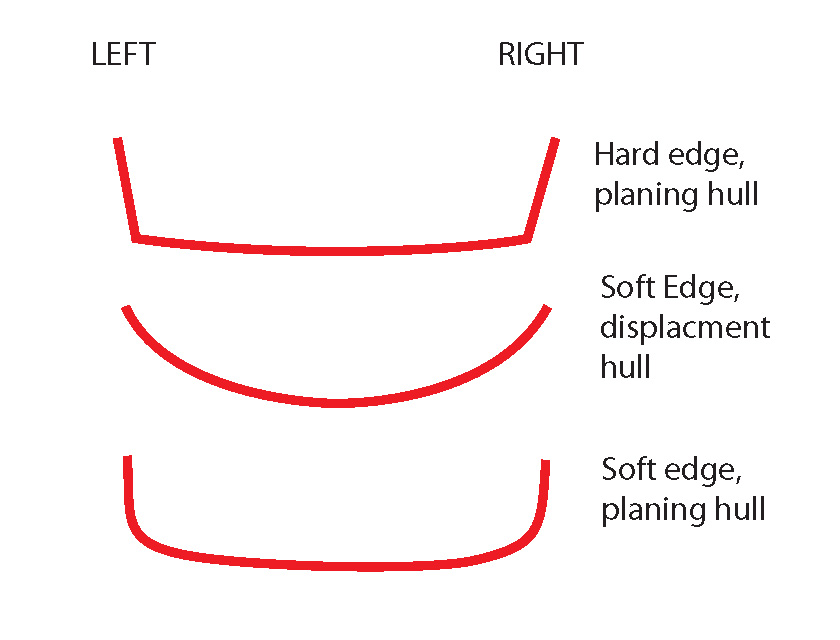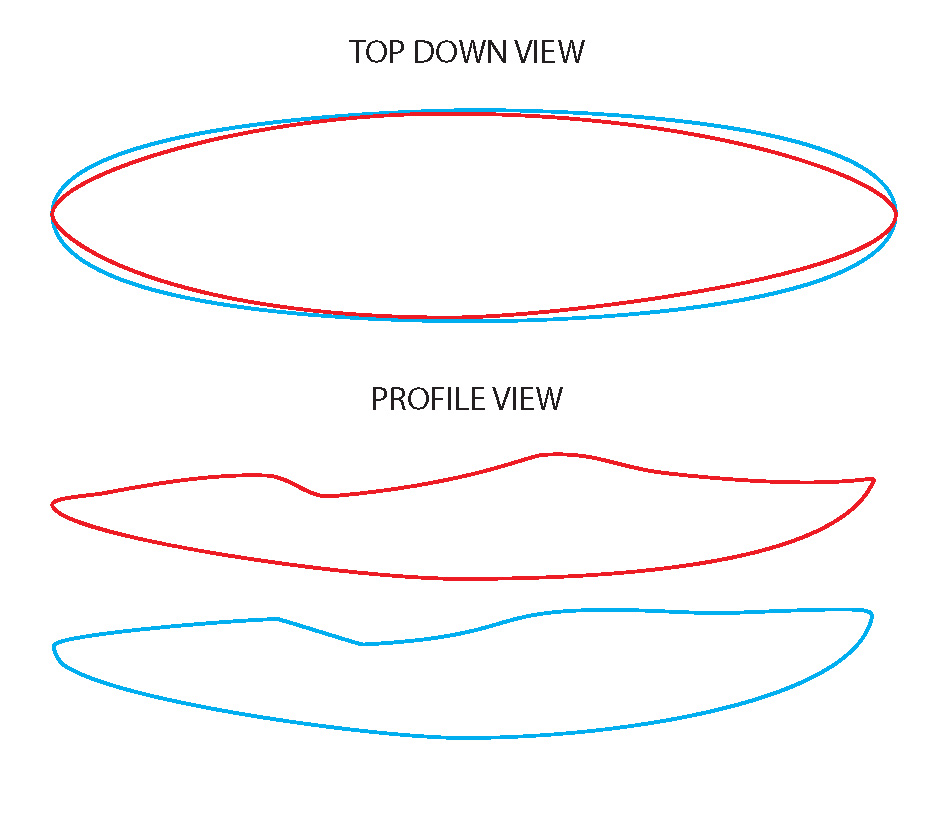Edge Profile and Hull Shape
Edge profiles can be considered on a continuum, where hard, angular edges represent one end, and rounded, indistinct edges the other.
The middle of this continuum would be soft edges.
Hull shape can be considered similarly, where displacement hulls are one extreme and planing hulls the other. The edge profile should always be considered in conjunction with the hull shape, although one does not determine the other. We’ll begin with edges.

Edges
Hard edges provide a “keel line” (a linear feature that resists spinning in the water) when the boat is put on edge, which allows the boat to maintain momentum moving in a relatively straight or broadly curved, trajectory. This makes boats with hard edges excellent at “carving” in and out of eddies when moving down river (this concept is not very far removed from carving on skis).
Hard edges also allow for more dynamic surfing, providing good directional boat control on a wave. As a result, hard edges are more common on river running boats. The drawback of hard edges is that they provide a place for water to pile up, or “catch,” on the boat, and they can hang up more on rocks. This makes boats with hard edges more challenging to paddle in boily and dynamic water, as well as shallow rivers that involve maneuvering over, around, and on lots of rocks.
In contrast, boats with indistinct or soft edges tend to have a “mushy” feel, because they do not engage with water as much as hard edges. (This is akin to skis with detuned edges that slide / smear turns rather than bite and carve.) They do allow for faster “pivoting” turns, however, as well as smoother moves off rocks (like smears and “airplane boofs”), and do not get hung up in boily water as easily. Creek boats tend to have softer edges.
Hull Shapes
Displacement hulls are rounded from edge to edge, and are often referred to as arch or shallow arch hulls (particularly in canoes and sea kayaks). Displacement hulls tend to be faster when moving downstream through water than planing hulls. They also tend to provide better secondary stability (i.e. stability on edge) than planing hull boats. Displacement hulls do not surf as well as planing hulls, however, so boats designed with surfing in mind will usually not incorporate displacement hulls.
One significant advantage of displacement hulls is the dissipation of impact force when landing large drops flat (typically drops over 15 of freefall).
Planing hulls are more or less flat from edge to edge. They accelerate quickly but do not maintain speed as well as displacement hull boats. This makes them more comfortable surfing and making dynamic eddy moves (like when attaining upstream or quickly ferrying across fast current). Additionally, planing hull boats often carry speed away from boofs better than displacement hull boats because of their ability to plane away on the surface.
Displacement hulls and planing hulls are more or less equally common on creek boats and river runners, however, because the differences in performance do not tend to impact boat suitability to creeks or rivers.
Boat designers also incorporate edges and hull shapes in different ways, so it is not uncommon to see a planing hull boat with soft edges (e.g. the LiquidLogic Stomper), a displacement hull boat with moderate edges (e.g. the Dagger Nomad), or any other combination of the two. Edges and hull shapes can both vary anywhere along their continuums from hard edge planing hull to indistinct edge displacement hull.
Volume Distribution
Volume distribution is often neglected in conversations about boat design (at least in the creek boat / river runner category) but contributes significantly to overall performance. Again, volume distribution can be thought of as being a continuum. On one end are boats whose volumes are centered on the cockpit. On the other end are boats whose volume is distributed into the bow and stern. To give an idea of how two boats can differ in volume distribution, have a look at the diagram showing a Jackson Zen (in red, volume more centered on the cockpit) and a LiquidLogic Stomper 90 (in blue, volume distributed throughout the bow and stern).

When volume is centered on the cockpit of a boat, the ends tend to be thinner in profile. Such boats feel “sportier” because the bow and stern engages the water more. This also allows the paddler to make dynamic moves like squirts more easily, and usually results in more maneuverability while surfing (because of less weight and volume in the ends). For these reasons, river running boats tend to have proportionally more of their volume around the cockpit than in the bow and stern.
When resurfacing speed and stability is important, however, having less volume in the bow and stern can be detrimental; boats with proportionally more of their volume distributed into the bow and stern tend to resurface more quickly and under more control. This is the result of increased buoyancy in the bow and stern, and less flattened bow and stern profiles.
Boats with more volume in the bow and stern also tend to be more resistant to burying the bow off ledges, and punching holes (instead they ride over holes). Added volume in the stern can also mitigate against the “backender” effect that is common for boats with lower volume sterns while punching holes. For these reasons, creek boats tend to have more volume distributed in the bow and stern than river-runners.
Bottom Line
There are an infinite number of possible boat designs, but no matter what a manufacturer claims, no single design can excel at everything.
Every boat necessarily has design tradeoffs, but if you know the type of whitewater you will be paddling the most and have a solid understanding of how different designs affect paddling performance, it is possible to make a reasonable assessment of boat characteristics before even paddling a boat or having to rely on manufacturer hype.

I need a kayak that is small and light weight. I am alone and not the strongest senior around. I live close to the ocean, lakes, creeks and rivers. I love to go out on the water but my problem is transporting the kayak. I need a sitin that’s fun, light and stable. I don’t need one to do tricks. Any suggestions? Thanks.
You’re in quite a pickle. An ocean kayak is long and narrow while a lake or flat-water river kayak is of mid-length and between narrow and wide. A white-water kayak for creeks and rivers is going to be short-to-mid length and around 24″ wide. Maybe something like a LiquidLogic Stinger would work for you. It’s long and narrow so it is a faster boat that people use for racing. It doesn’t have the same bottom as an ocean or recreational boat so I’m not sure how effective it’d be on ocean water — flat water it’d be fine if you have a good forward stroke. The Stinger XP is similar to the Stinger in shape and size but it comes with a dry hatch in the rear and a retractable skeg so you can track easier in flat water; those features come at the expense of the maneuverability. The Stinger XP weighs 55lbs which is heavy for a kayak, but since it has dry storage maybe you can fit a kayak pull cart in the back?
And be careful paddling alone and always wear a PFD (and helmet if there’s rocks!)
If planning to do some traveling and hitting a lot of different types of water some mild class 1 -2 rivers and also making my way to some more serious class 4- 5 rivers is a Jackson zen a good all around choice?
Awesome article, thank you so much!
Great article! Thanks. I am designing a wooden pirogue/canoe for use paddling or with a small electric troll motor. For inland SE river class 1 or 2…more class one. I need to be able to paddle upstream. My current canoe is a Mad River Explorer, 15 ft. The soft edge hull design without keel is very helpful going upstream and diagonally across current. Trying to decide length and hull shape. Targeting 12 to 14 ft, ( I am 240lbs 6 ft.) This would be a one man boat. I am leaning toward a soft edge planning hull. The widest portion of the hull would be toward the stern maybe 32 inches tapering to a point on the bow. I don’t think I can do a proper soft edge with plywood so leaning toward cedar strap. I also want to keep the hull thickness to a minimum. Thinking of an interior deck of thin hardwood reinforced in the small area in front of the seat where I step 90% of the time. Would like any advise about hull thickness, design , location of the seat, any advice. Thank you
So is there a review site/channel that reviews grade 2-3 river running? I know I will not reach grade 4 for several good reasons.
The videos I have found video’s seem to focus on grade 4-5 running to the sound of adrenalinised music, and are always highly complimentary. Every year the new boat is amazing, and I can’t tell who is sponsored.